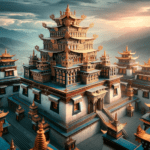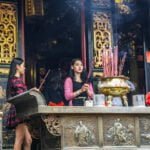A Brief History
Guandi Temple, known as “Gesar Lhakhang” in Tibetan, meaning “Gesar’s Temple,” stands as a remarkable testament to the fusion of Han and Tibetan cultures. Built after the Qing dynasty general Fukang’an defeated the Gurkha (Nepali) army, this temple is located on Bamari Mountain, west of the Potala Palace, and was constructed in 1791. The architecture is a fascinating blend, with the temple facing south in the traditional Han style, yet it incorporates Tibetan elements, making it a unique site of cultural harmony.
Architectural Marvel
The main hall of the temple is an architectural gem, with a depth of 9.7 meters and a width of 12.5 meters, complemented by a front porch. The interior showcases a traditional Chinese lifted beam structure, while the exterior boasts Tibetan-style stone walls topped with red glazed tiles, adding a vibrant splash of color. The corners of the temple are adorned with flying eaves, a feature that enhances its majestic presence.
Inside the Main Hall
Upon entering the main hall, visitors are greeted by the imposing statue of Guan Yu, the revered military general known for his loyalty and valor, wielding his legendary guandao. Alongside him stands his sworn brother Zhang Fei, depicted with a fierce and courageous demeanor. Locals refer to Guan Yu as “Gesar Gyalpo,” reflecting his esteemed status in both cultures.
The Buddha Hall
Behind the main hall lies the Buddha Hall, or “Jamyang Lhakhang,” dedicated to Manjushri, the Bodhisattva of Wisdom. This hall is home to exquisite statues of Manjushri, flanked by Vajrapani and the Thousand-Armed Avalokiteshvara, each figure embodying grace and divinity. Despite the Han architectural influence, the temple’s Buddhist statues are distinctly Tibetan, showcasing the deep integration of artistic styles and spiritual traditions.
A Testament to Cultural Integration
The evolution of Guandi Temple from a symbol of military victory to a place of spiritual significance illustrates the dynamic exchange and blending of Han and Tibetan cultures. This temple not only serves as a place of worship but also as a reminder of the rich, interconnected history that shapes the region.
Visiting Guandi Temple offers a unique opportunity to explore the architectural beauty and cultural depth of a site where two distinct traditions converge in harmony. Whether you’re drawn to its historical significance or its spiritual ambiance, Guandi Temple stands as a beacon of unity and cultural exchange.
Exploring the Unique Features of Guandi Temple
Guandi Temple, nestled in the heart of Tibet, holds not just spiritual and historical significance but also presents intriguing features that pique the curiosity of many visitors. Here are some of the unique aspects of this temple that make it a must-visit for anyone exploring the region.
Fascinating Totems
One of the most interesting visual features you’ll notice at Guandi Temple are the totems depicting reproductive organs located near the roof on the outer walls of the temple. These totems, a rare sight in the context of a temple, add an intriguing layer to the cultural and spiritual tapestry of the place.
The Guandi Temple Stele
Just inside the temple’s main gate stands the “New Guandi Temple Stele of Mopan Mountain,” erected in 1793. This monument, measuring 2.92 meters in height, 1.17 meters in width, and 0.29 meters in thickness, features a relief of two dragons playing with a pearl and is inscribed with the characters for “Eternal Prosperity.” The stele documents the Qing dynasty’s military expedition to Tibet to quell the Gurkha army and the construction of Guandi Temple, offering valuable insights into its historical and artistic significance.
Visitor Tips
- The Magical Stone Wall: At the corner of Deji Middle Road, below the temple, there’s a mysterious blackened stone wall. It’s polished to a shine from countless people rubbing against it, seeking relief from leg pain. It’s said that a few rubs against this wall can have unexpected healing effects.
- Releasing Chickens: Releasing chickens is a unique custom associated with Guandi Temple. It’s common to see local Tibetans bringing chickens here to set them free, so don’t be surprised to find flocks of chickens foraging around the temple grounds. This practice adds a special charm to the temple’s ambiance and speaks to the local customs of compassion and animal welfare.
Visiting Guandi Temple offers a deep dive into the rich tapestry of Tibetan culture, where history, spirituality, and unique traditions come together in a fascinating display. Whether you’re drawn to its architectural beauty, intrigued by its unusual totems, or interested in participating in local customs, Guandi Temple provides a memorable experience for all.














